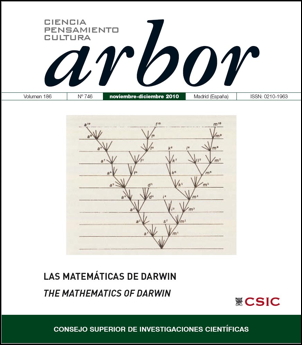¿Estamos asistiendo a una era de teorización de la biología?
DOI:
https://doi.org/10.3989/arbor.2010.746n1255Palabras clave:
Biología teórica, estocasticidad, formación de patrones, modelos cinéticosResumen
Durante los últimos años ha habido un creciente interés por parte de físicos y matemáticos en el estudio de problemas que surgen al tratar de comprender cuestiones de biología. Por otra parte los avances en las técnicas experimentales están permitiendo obtener una gran cantidad de información sobre los mecanismos que emplean las células en su funcionamiento. En este artículo se describen algunas líneas de investigación en matemáticas cuyo estudio ha sido motivado por el estudio de problemas biológicos.
Descargas
Citas
1 W. Alt, “Biased random walks models for chemotaxis and related diffusion approximations”, J. Math. Biol. 9, 147-177, 1980. doi:10.1007/BF00275919 PMid:7365332
2 W. Alt y M. Dembo, “Cytoplasm dynamics and cell motion: Two phase flow models”, Mathematical Biosciences 156, 207-228, 1999. doi:10.1016/S0025-5564(98)10067-6
3 D. Andreucci, P. Bisegna, G. Caruso, H. E. Hamm y E. DiBenedetto, “Mathematical models of the spatio-temporal dynamics of second messengers in visual transduction”, Biophysical J. 85, 1358-1376, 2003. doi:10.1016/S0006-3495(03)74570-6
4 A.L. Barabási, Linked: The New Science of Networks, Perseus, Cambridge, MA, 2002.
5 H. C. Berg, Random walks in biology, Princeton Univ. Press, 1993.
6 T. Bollenbach, K. Kruse, P. Pantazis, M. González-Gaitán, F. Jülicher, “Robust formation of morphogen gradients”, Phys. Rev. Lett. 94, 2005.
7 E. O. Budrene y H. C. Berg, “Dynamics of formation of symmetrical patterns by chemotactic bacteria”, Nature 376, 49-53, 1995. doi:10.1038/376049a0 PMid:7596432
8 D’Arcy Thompson, On Growth and Form, Cambridge University Press, 1942.
9 R. B. Dickinson y R. T. Tranquillo, “Transport equations and indices for random and biased cell migration based on single cell properties”, SIAM J. Appl. Math. 55, 5, 1419-1454, 1995. doi:10.1137/S003613999223733X
10 S. Douady y Y. Couder, “Phyllotaxis as a physical self-organized growth process”, Phys. Rev. Lett. 68, 2098-2101, 1992. doi:10.1103/PhysRevLett.68.2098 PMid:10045303
11 R. Erban, I. G. Kevrekidis, David Adalsteinsson, Timothy C. Elston, “Gene regulatory networks: a coarse-grained, equation-free approach to multiscale computation”, Journal of Chemical Physics, Volume 124, Issue 8, 084106, 17 pages, 2006.
12 R. Erban and J. Chapman, “Stochastic modelling of reaction-diffusion processes: algorithms for bimolecular reactions”, Physical Biology, vol. 6, n.º 4, 046001, 2009.
13 M. Feinberg, “The existence and uniqueness of steady states for a class of chemical reaction networks”, Arch. Rat. Mech. Anal., 132, 311-370, 1995. doi:10.1007/BF00375614
14 Y. C. Fung, Biomechanics, Springer Verlag, 1984.
15 E. Geigant y M. Stoll, “Bifurcation analysis of an orientational aggregation model”, J. Math. Biol. 46 (6), 537-563, 2003. doi:10.1007/s00285-002-0187-1 PMid:12783181
16 D. T. Gillespie, “A general method for numerically simulating the stochastic time evolution of coupled chemical reactions”, J. Comput. Phys. 22: 403-34, 1976. doi:10.1016/0021-9991(76)90041-3
17 A. Marciniak-Czochra, “Receptorbased models with diffusion-driven instability for pattern formation in hydra”, J. Biol. Sys. 11: 293-324, 2003. doi:10.1142/S0218339003000889
18 H. Meinhardt, A. Gierer, “Applications of a theory of biological pattern formation based on lateral inhibition”, J. Cell Sci. 15, 321-346, 1974. PMid:4859215
19 N. Mittal, E. O. Budrene, M. P. Brenner y A. van Oudenaarden, “Motility of Escherilia coli cells in clusters formed by chemotactic aggregation”, Proc. Nat. Acad. Sci. 100, 23, 13259-13263, 2003. doi:10.1073/pnas.2233626100 PMid:14597724 PMCid:263772
20 A. Mogilner y L. Edelstein-Keshet, “Spatio-angular order in populations of self-aligning objects: formation of oriented patches”, Phys. D 89, 3-4, 346-367, 1996.
21 C. Nüsslein-Volhard, Coming to Life, How genes drive development, Kales Press, 2006.
22 H. G. Othmer and A. Stevens, “Aggregation, blow-up and collapse. The ABC’s of taxis in reinforced random walks”, SIAM J. Appl. Math. 57, 4, 1044-1081, 1997.
23 C. S. Patlak, “Random walk with persistence and external bias”, Bull. Math. Biophysics 15, 311-338, 1957. doi:10.1007/BF02476407
24 J. A. Sherratt, P. K. Maini, W. Jäger, W. Müller, “A receptor based model for pattern formation in hydra”, Forma 10, 77-95, 1995.
25 G. Shinar, U. Alon y M. Feinberg, “Sensitivity and robustness in chemical reaction networks”, SIAM J. Appl. Math., vol. 69, 4, 977-998, 2009. doi:10.1137/080719820
26 E. Schrödinger (1944): What is life?, Cambridge University Press.
27 A. Stevens y J. J. L. Velázquez, “PDEs and Non-diffusive structures”, Nonlinearity, 21 T283-T289, 2008.
28 A. Trembley, Memoires pour servir à l’histoire d’un genre de polypes d’eau douce, à bras en forme de cornes, Jean and Herman Verbeek, Leiden, 1744.
29 A. M. Turing, “The chemical basis of morphogenesis”, Phil. Trans. Roy. Soc., B 237 37-72, 1952.
30 S. Vogel, Life in Moving Fluids: The Physical Biology of Flow, Princeton Univ. Press, 1996.
31 A. Wagner, Robustness and Evolvability in Living Systems, Princeton University Press, 2005.
Descargas
Publicado
Cómo citar
Número
Sección
Licencia
Derechos de autor 2010 Consejo Superior de Investigaciones Científicas (CSIC)

Esta obra está bajo una licencia internacional Creative Commons Atribución 4.0.
© CSIC. Los originales publicados en las ediciones impresa y electrónica de esta Revista son propiedad del Consejo Superior de Investigaciones Científicas, siendo necesario citar la procedencia en cualquier reproducción parcial o total.
Salvo indicación contraria, todos los contenidos de la edición electrónica se distribuyen bajo una licencia de uso y distribución “Creative Commons Reconocimiento 4.0 Internacional ” (CC BY 4.0). Consulte la versión informativa y el texto legal de la licencia. Esta circunstancia ha de hacerse constar expresamente de esta forma cuando sea necesario.
No se autoriza el depósito en repositorios, páginas web personales o similares de cualquier otra versión distinta a la publicada por el editor.














